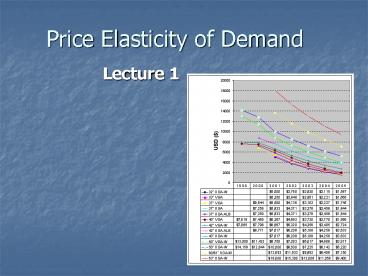Price Elasticity of Demand PowerPoint PPT Presentation
1 / 22
Title: Price Elasticity of Demand
1
Price Elasticity of Demand
- Lecture 1
2
Demand Curves Show How Sensitive Consumers are to
Price Changes
Relatively inelastic 1. Quantity demanded is not
affected very much by price changes. 2.
Therefore not very sensitive to price
changes. 3. Not many substitutes, short period
of time, and small proportion of budget. 4.
? Q is not as great as the???P.
P
Demand
Quantity Demanded/unit time
3
Demand Curves Show How Sensitive Consumers are to
Price Changes
Relatively elastic 1. Quantity demanded is
affected very much by price changes. 2.
Therefore very sensitive to price changes.
3. Many substitutes, long period
of time, and large
proportion of
budget. 4. ? Q is greater than the???P.
P
Demand
Quantity Demanded/unit time
4
Elastic? or,
Corn
Here the slope relates that the quantity demanded
is very sensitive to price changes
Price
1000 bu./month
5
Inelastic?
BUT a change in the scale of measure changes the
graph so as to make it look as though the
quantity demanded is NOT very sensitive to
changes in price !
Corn
Price
6
5
4
3
2
1
1
2
3
4
5
million bu/month
6
Calculating Elasticity
- Due to the problems with scaling depicted here,
we rely on a mathematical determination of
elasticity.
7
Price Elasticity of Demand (Ed)
- Ed
- percentage change in quantity demanded
- --------------------------------------------------
---- - percentage change in price
8
Calculating Ed
- Ed
- ?Qd / ?P
- (?Qd / ?P) P0 / Q0
- (1 / Slope) P0 / Q0
All 3 of these equations yield the same answer
9
Interpreting an Elasticity Estimate
- If Ed were to - .75, what does it tell us?
- For every 1 change in price, Qd will change
.75 in the opposite direction
10
Example
- P0 8 P1 7
- Q0 40 Q1 48
- Step 1 ?Q 48 - 40 8
- ?P 7 - 8 -1
- Step 2 Use the formula for Ed.
11
- Step 3
- Ed (?Qd / ?P) P0 / Q0
- (8 /-1) (8/40) - 1.6
12
- Step 4
- This means that for every 1 change in price
that there is a 1.6 change in quantity demanded
in the opposite direction.
13
- Since we know that an Ed - 1.6 means that a 1
change in price results in a 1.6 change in
quantity demanded in the opposite direction, - What would a 20 increase in price result in?
14
- Step 1 Ed ??Q / ? P
- Step 2 ??Q Ed ? P
- Step 3 ? Q - 1.6 20 - 32
15
- What would a 20 increase in the quantity
demanded result in ? - Step 1 Ed ??Q / ? P
- Step 2 ? P 1 / Ed ? Q
16
- Step 3
- ? P (1 / - 1.6) 20 - 12.5
17
- If you have trouble with algebraic derivations of
an equation then, - REMEMBER
- ?P X Ed ?Q
- ?Qd X (1 / Ed) ?P
18
- We now know how to mathematically determine Ed,
what does it tell us about elasticity ? - Economist usually drop the negative sign of the
elasticity of demand for they know that P
??????Q??.
19
- ?Ed? gt 1 ? elastic demand (very responsive
- to price changes).
- ?Ed?lt 1 ? inelastic demand (not very
- sensitive to prices).
- ?Ed? 1 ? unitary elastic (ratio of ?s 1).
20
- ?Ed? gt 1 ? ?Q gt ?P
- ?Ed?lt 1 ? ?Q lt ?P.
- ?Ed? 1 ? ?Q ?P.
21
1971 Estimates of Price Elasticity of Demand at
Retail in the World
- Ed
- beef - .6438
- chicken -.7773
- milk -.3455
- sugar -.2419
- bread -.1500
- all foods -.2368
- non foods -1.0179
22
References
- N.c.State university-College of Agriculture and
Life science Dr. herman_sampson

